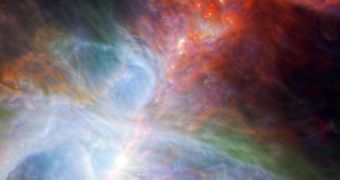Using data from the European Space Agency's (ESA) Herschel Space Observatory and the NASA Spitzer Space Telescope, a team of astronomers was recently able to observe a number of blue stars in the Orion Nebula, as they were undergoing intricate transformations right in front of their eyes.
The effect was given by the fact that the young stellar objects were being observed during a critical stage in their lives, when they are only a little way from reaching maturity. They are currently wreaking havoc in their surroundings through impressively strong stellar winds.
Spitzer observes the stars in infrared wavelengths, which can penetrate through the thick layers of cosmic dust and hydrogen gas smothering the forming objects. As such, it basically sees the heat signature these stars release.
When they undergo such extreme temperature variations, the forming fireballs register like fireworks on the sensitive detectors aboard Spitzer and Herschel. The weird thing about this particular stellar population is that the aforementioned variations occur at very brief intervals.
In the image to the left, the Orion nebula sector where these blue stars are located shines in a multitude of colors, which are produced by the light filters used on the two telescopes. Experts used them together because Spitzer can see very short wavelengths, whereas Herschel thrives at longer ones.
Astronomers at the NASA Jet Propulsion Laboratory (JPL), in Pasadena, say that the stars are still at the very earliest stages in their evolution. The lab manages the Spitzer telescope, and is also involved in Herschel's operations through a partnership with the European Space Agency.
“Herschel's exquisite sensitivity opens up new possibilities for astronomers to study star formation, and we are very excited to have witnessed short-term variability in Orion protostars,” Nicolas Billot says.
“Follow-up observations with Herschel will help us identify the physical processes responsible for the variability,” adds the Institut de Radioastronomie Millimétrique (IRAM) expert. He and his team are currently compiling a new paper on the recent observations.
“Herschel mapped this region of the sky once a week for six weeks in the late winter and spring of 2011,” a press release from the JPL reads.
“To monitor for activity in protostars, Herschel's PACS [instrument]probed long infrared wavelengths of light that trace cold dust particles, while Spitzer gaged the warmer dust emitting shorter infrared wavelengths,” the statement concludes.

 14 DAY TRIAL //
14 DAY TRIAL //